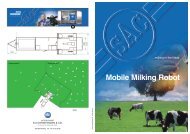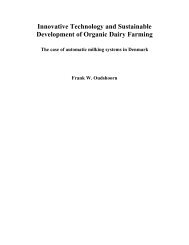Validation of Calibration Equations Developed ... - Automatic Milking
Validation of Calibration Equations Developed ... - Automatic Milking
Validation of Calibration Equations Developed ... - Automatic Milking
Create successful ePaper yourself
Turn your PDF publications into a flip-book with our unique Google optimized e-Paper software.
The early season equation predicted yield with low precision, which is expected for sward<br />
height observations made after mid July. The early season equation is, according to results<br />
reported by Hansson (2011) (Figure 4.1), also expected to overestimate the yield for sward<br />
heights below approximately 200mm compared to yields predicted with the late season<br />
equation at same height. This expectation was confirmed by the mean difference between<br />
the predicted and actual yield reported in Table 3.1 and 3.2.<br />
For sward heights below approximately 180mm the calibration equation without seasonal<br />
effects is expected to overestimate the predicted yield in relation to the late season<br />
equation (Figure 4.1). Table 3.1 and 3.2 confirms that the yield predicted by the equation<br />
without seasonal effects is, on average, higher than the yield predicted by the late season<br />
equation. The overestimation by the equation without seasonal effects was further expected<br />
to be less than the overestimation by early season equation (Figure 4.1), which again was<br />
confirmed by mean differences reported in Table 3.1 and 3.2.<br />
The sward height range in which the calibration observations are made is <strong>of</strong> importance for<br />
future predictions. The results from the analysis <strong>of</strong> the whole dataset were compared to the<br />
results from the analysis <strong>of</strong> the subset which only included observations <strong>of</strong> heights that were<br />
within the same range <strong>of</strong> sward heights observed in the calibration trial. This comparison<br />
shows that predictions made from height observations within this range only were closer to<br />
the actual yield than if the predictions were made from all observed heights, outside or<br />
within the range (c.f. Table 3.1 and 3.2).<br />
The percentage <strong>of</strong> predictions that is within ±10% <strong>of</strong> the actual yield, calculated for each<br />
calibration equation, is not in concurrence with the results reported in Table 3.1 and 3.2. In<br />
Table 3.1 and 3.2 the early season calibration equation predictions, on average, deviates the<br />
most from the actual yield. The percentage <strong>of</strong> predictions by early season equation that are<br />
within ±10% is, however, the same as the corresponding percentage for late season<br />
equation and higher than the corresponding percentage for equation without seasonal<br />
effects. This is seen both in the analysis <strong>of</strong> the whole dataset and the subset <strong>of</strong> data. The<br />
contradictory results are most likely caused by a few greatly deviating observations<br />
influencing the mean difference between predicted and actual yield. These observations are,<br />
however, not outliers in a mathematical sense and were therefore not identified in the<br />
statistical test for outliers.<br />
12




